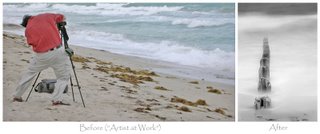
My Blog (and I) have been off-line for a while, as my family and I enjoyed a well-earned vacation. This short entry, to recouple myself to the Blog world, is titled "Artist at Work" - and contains a wink, ";-)" - at the end because I am decidedly poking a bit of fun at myself. While I aspire to one day attain the right to call myself an "Artist," I have also retained enough objectivity in my short life to appreciate I have a way to go to get to that point.
The image shown above is a before and after shot. The before shot (on the left-hand-side) exists by courtesy of my beautiful (and brave) wife, who was with me on the Florida beach as yours truly was (incredibly, and somewhat idiotically!) taking a series of Hiroshi Sugimoto-like long-exposures of some pylons sticking out of the water as it, the beach, and my wife and I were pummeled by close-to-hurricane-level winds! The after shot (on the right; "after" referring to the physically banged up state my wife and I were in after braving the inhumanly vicious winds!) was among the several images I somewhow managed to capture without my hat, camera, tripod, and bag being blown half-way to Cuba.
Suffice it to say that I now understand two things about my photography (and physical state):
1. That it is not why I take the pictures of the things I tend to take the pictures of (leaves, reeds, vines, dilapidated buildings, ...) that people stare at me when I take pictures with a mixture of bemusement and incredulity; rather, people stare at me with a mixture of bemusement and incredulity because of how I take my pictures.
2. The reason my back (and neck, and shoulders, and knees, and ...) seem to hurt all the time has less to do with the inevitable age-creep (I'm only 45 for Goodness sake;-), and everything to do with the contortions I put my poor body through to get that next shot! (The irony is that my body, in the act of capturing the beauty of dilapidated buildings, is itself succumbing - rapidly - to the same entropic decay!)
When I said to my wife (while laughing at what I thought was a "fluke" picture of me in a comically and awkwardly wrenched position), "Hey, you were lucky to catch me like that!"... it was my turn to stare at my wife (with a mixture of bemusement and incredulity;-) when she gently, but firmly, assured me that I always look like that when taking pictures. Whether I am in a mini-hurricane (as above), or precariously balanced on a ledge on some cliff in Hawaii, or delicately (and typically not all-too-well) poised on one leg on a small rock in the middle of a babbling brook, I'm always scrunched up like a pretzel!
The "Artist at Work" indeed!
